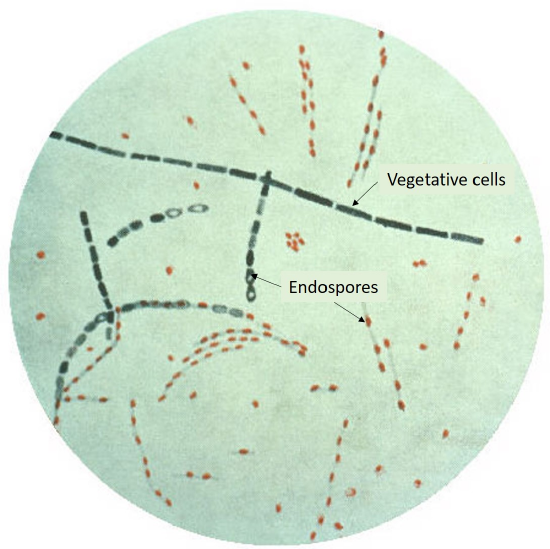15.1.1.1: Bacillus anthracis
- Page ID
- 42648
\( \newcommand{\vecs}[1]{\overset { \scriptstyle \rightharpoonup} {\mathbf{#1}} } \) \( \newcommand{\vecd}[1]{\overset{-\!-\!\rightharpoonup}{\vphantom{a}\smash {#1}}} \)\(\newcommand{\id}{\mathrm{id}}\) \( \newcommand{\Span}{\mathrm{span}}\) \( \newcommand{\kernel}{\mathrm{null}\,}\) \( \newcommand{\range}{\mathrm{range}\,}\) \( \newcommand{\RealPart}{\mathrm{Re}}\) \( \newcommand{\ImaginaryPart}{\mathrm{Im}}\) \( \newcommand{\Argument}{\mathrm{Arg}}\) \( \newcommand{\norm}[1]{\| #1 \|}\) \( \newcommand{\inner}[2]{\langle #1, #2 \rangle}\) \( \newcommand{\Span}{\mathrm{span}}\) \(\newcommand{\id}{\mathrm{id}}\) \( \newcommand{\Span}{\mathrm{span}}\) \( \newcommand{\kernel}{\mathrm{null}\,}\) \( \newcommand{\range}{\mathrm{range}\,}\) \( \newcommand{\RealPart}{\mathrm{Re}}\) \( \newcommand{\ImaginaryPart}{\mathrm{Im}}\) \( \newcommand{\Argument}{\mathrm{Arg}}\) \( \newcommand{\norm}[1]{\| #1 \|}\) \( \newcommand{\inner}[2]{\langle #1, #2 \rangle}\) \( \newcommand{\Span}{\mathrm{span}}\)\(\newcommand{\AA}{\unicode[.8,0]{x212B}}\)

Endospore stain of Bacillus anthracis. (Copyright; Kristen Catlin, Public Health Image Library. 2009.)
Organism
- Bacillus anthracis is a large, Gram-positive endospore-forming rod, often found as streptobacilli
- A catalase-positive facultative anaerobe which metabolizes using both aerobic respiration and fermentation
- Able to use a wide variety of sugars and other biological material as carbon and energy sources
- Encapsulated. Unlike most bacterial capsules which are polysaccharide, the B. anthracis capsule is a polymer of the amino acid glutamate.
Habitat
- Soil, particularly in locations with an active outbreak
- Can be found in/on wool, fur, hair, and hides of livestock or other animals which have been exposed
Source
- Historically of most concern as a lethal pathogen of livestock
- Most natural infections of humans arise from exposure through contaminated animal products
- Has been utilized as a biological weapon, notably in the months following the terrorist attacks of September 11, 2001
Epidemiology
- Naturally occurs infrequently and sporadically
- Environmental endospores are introduced into compromised skin, inhaled, or ingested
Clinical Disease
- Cutaneous anthrax:
- The least dangerous form of anthrax (~20% mortality rate without treatment)
- Endospores enter through compromised skin and germinate, causing a localized infection
- Produces a black necrotic lesion with a coal-like appearance; this is the source of its name (the same word route as the coal variety anthracite)
- This form of anthrax is usually easily cured with antibiotic treatment
- If the B. anthracis is able to enter the bloodstream from the infection site, however, it is highly likely to be fatal
- Inhalational anthrax:
- Occurs when endospores are inhaled and germinate in lungs, leading to infection
- Sometimes called “woolsorter’s disease” due to its associated with exposure to animal products such as wool or hides
- Early symptoms can resemble pneumonia or flu
- Can lead to hemorrhaging in the lungs
- Can be treated with antibiotics if diagnosed quickly, but much more likely to be fatal than cutaneous anthrax (~80% mortality rate)
- Gastrointestinal anthrax:
- Occurs when endospores are ingested
- Very rare form of anthrax
- Reported mortality rates vary from ~25-75%
Primary Virulence Factors
- Poly-D-glutamyl capsule
- Anthrax toxin
- AB exotoxin
- Two active (A) components: edema factor (EF) and lethal factor (LF)
- Binding (B) component: protective antigen (PA)
Additional information: http://textbookofbacteriology.net/Anthrax.html

